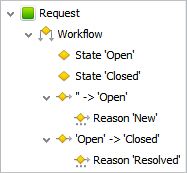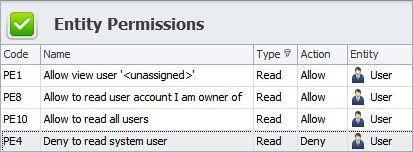Business Objects & Workflow Management in Database Programming
Database programming can be defined as the art of ensuring simplicity and flexibility in data storing, manipulation and retrieval to free up untrained human resources from tedious and sophisticated programming tasks. It aims to create a user-friendly interface to make it easier for real users to keep, update, and retrieve necessary business information. Ideally, there should be a kind of database configuration tool that could allow users to create, set up and customize their databases. CentriQS Configurator provides a simple intuitive interface that helps users configure databases according to their specific business needs. This tool doesn't require database programming knowledge but ensures simplicity and flexibility in database building and customization.
Creating Business Objects
Database programming solution provides a number of information processing and structuring advantages that are extremely helpful for managing business objects (aka "entities"). Users are enabled to create different tailor-made objects in their database to structure and carry out business activities. In particular, you can use CentriQS Configurator to add custom entities to your database to weave a map of your business processes.
For instance, to model the sales process of your company you can create such entities as 'Customer', 'Issue', 'Order' and 'Payment'. These entities will create the Customer view, the Issue view, the Order view and the Payment view in the database to enable you to see client profiles, manage sales orders, track payments, and record issues.

Business Workflow Management
A company's ability to manage business workflow greatly depends on how well the information on procedures, tasks, events, interactions, etc. is organized in database programming tool. Users with no dedicated education and expertise in programming should easily access and change necessary workflow data. Then they would be able to maintain and customize business workflow.
Set Business Workflow Components
In CentriQS Configurator you can create workflow for your business entities. Workflow consists of several components (incl. State, Reason, Transition, Action) to define progression of steps for a certain business process. For example, to manage client requests you can create the following workflow for the entity 'Request':
Client Request Workflow:
- State - 'Open'
- State - 'Closed'
- Transition - 'Open' with Reason 'New'
- Transition - 'Open' to 'Closed' with Reason 'Resolved'

Planning and Analysis
Before doing anything in business, every successful company needs to pinpoint its business needs, analyze current situation and create an action plan. Planning and analysis will be the core activities that lead to greater performance and business success.
Database programming in CentriQS
Database programming solutions should help companies meet their business requirements, plan out the course of action and get analytic data for review and reporting. With help of CentriQS Configurator you can create analytic views for planning, analyzing and reviewing your business activities. In particular, you can create the Sales Analytics view in your database to analyze and plan your sales by Order Date, Region, Sales Amount, Number of Orders, Customer, Salesperson and Product. You can combine these properties to create pivot tables in the Sales Analytics view.

Database User Administration
User administration is one of the most critical functions for any relational database. It determines which and how users will access the database, what rights and permissions they will have, where their profiles will be kept. When programming your database design, you need to consider all these issues in order to ensure effective data management and security.
User Permissions and Access Rights
Access to a database is defined by user permissions. Database administrators are likely to have full permissions, but non-administrative user access needs to be defined according to an employee's role and responsibility in the company. For example, a sales manager needs to have full access to all sales data (e.g. client accounts, orders, finances, reports, etc.), while a sales agent needs to access only a portion of the data, for example client accounts and orders.
In CentriQS you can use the Entity Permissions view to define user access rights to database entities. The permissions system allows or denies users to view or modify entity data. For managers you can set full access to the database, while for non-managerial personnel you can allow to modify only selected entity views.

User Types and Profiles
User and Group are two user types that can be created in a database.
- The User type means a registration account created for an employee to allow this employee to log in and navigate through the database, according to the account's settings. For example, user account "David Edison" is created for David Edison, a marketing head, who can view and modify all marketing data stored in the database.
- The Group type combines two or more users into a group that has certain database access rights, and thereby all the users are given the same permissions, according to the group's settings. For instance, group "Development Team" includes programmers from the development department, and they are allowed to access all data relating to the department's activity.

A user profile provides a detailed description of the characteristics of each database user, regardless of which type this user is assigned to. For example, CentriQS features the Users and Groups view that lists all users and groups registered in your database. Each user's profile can be specified with multiple properties including First Name, Last Name, Folder, Company, Password, Email, Phone Number, and more.
Windows Active Directory Authentication
Advanced software for database programming and customization allows using Windows Active Directory to authenticate users in relational databases. This capability lets companies (especially large ones that have multiple Active Directory user profiles) simplify user administration as they do not have to create new users or groups but just import existing records from Windows AD. CentriQS supports this capability so you can add domain users and domain groups to your database. You will enjoy using this program in Windows environments.

Prev.: Database Design Tool for Business Data Modelling || Next: Choosing the Best of Database Software Applications
Next steps
{
Check out CentriQS FEATURES & SCREENSHOTS
Watch 7-minute CentriQS VIDEO OVERVIEW
Learn how to use CentriQS in KNOWLEDGE BASE
DOWNLOAD CentriQS 30-day Free Trial Version
CONTACT US to get help with CentriQS Database Design & Configuration